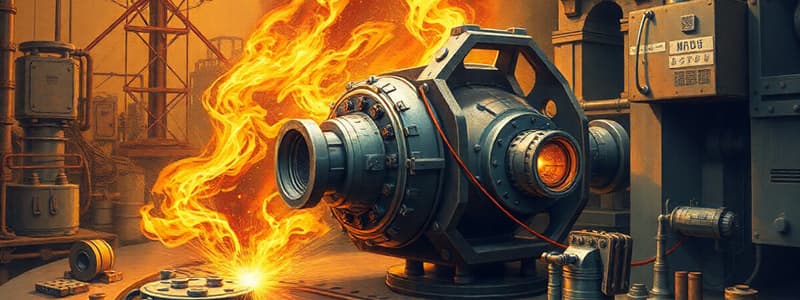Podcast
Questions and Answers
What is the main purpose of the turning process?
What is the main purpose of the turning process?
- To remove material to reduce the diameter of a rotating workpiece (correct)
- To create a flat surface on a workpiece
- To shape a metal sheet into a specific form
- To cut spiral threads into a workpiece
In the deep drawing process, a punch is used to compress the material into a die.
In the deep drawing process, a punch is used to compress the material into a die.
True (A)
What term describes the material that is removed by a cutting tool in the turning process?
What term describes the material that is removed by a cutting tool in the turning process?
chip
In slab milling, the direction of the cutter's movement is __________ to the rotation of the cutter.
In slab milling, the direction of the cutter's movement is __________ to the rotation of the cutter.
Which of the following processes specifically involves creating a flat surface on a cylindrical workpiece?
Which of the following processes specifically involves creating a flat surface on a cylindrical workpiece?
The threading process only involves the rotary motion of the workpiece.
The threading process only involves the rotary motion of the workpiece.
In powder metallurgy, what is the main outcome of compressing the metal powder?
In powder metallurgy, what is the main outcome of compressing the metal powder?
Match the following manufacturing processes with their descriptions:
Match the following manufacturing processes with their descriptions:
Flashcards
Powder Metallurgy
Powder Metallurgy
A manufacturing process where metal powder is compressed and shaped into a desired form under pressure, resulting in a compact metal part.
Turning
Turning
A machining process that uses a single-point cutting tool to remove material from a rotating workpiece, reducing its diameter.
Facing
Facing
A machining process that creates a flat surface on a workpiece by removing material with a single-point cutting tool.
Threading
Threading
Signup and view all the flashcards
Slab Milling
Slab Milling
Signup and view all the flashcards
Deep Drawing
Deep Drawing
Signup and view all the flashcards
Feed (in machining)
Feed (in machining)
Signup and view all the flashcards
Rotation (in machining)
Rotation (in machining)
Signup and view all the flashcards
Study Notes
Powder Metallurgy
- Powder metallurgy is a process where metal powders are compacted and then sintered to form a solid component.
- Initial step involves preparing metal powders. These powders are then compacted into a desired shape.
- The compacted powder is then heated (sintered) at a specific temperature below the melting point of the metal, bonding the particles together.
Turning
- Turning is a machining process where a single-point cutting tool removes material from a rotating workpiece to create a cylindrical shape.
- A single-point cutting tool is used to remove material.
- The workpiece rotates, while the cutting tool moves along the workpiece's axis to produce the desired shape.
- Starting diameter and chip are important features of the process.
Facing
- Facing is an operation in machining which generates a flat surface on the end of a workpiece.
- A single-point cutting tool is used.
- The workpiece rotates while the tool moves along the axis of rotation to create a flat face on the end of the workpiece.
Threading
- Threading is a machining process creating a helical groove on a workpiece to produce a thread.
- A threading tool is used for producing threads.
- The tool creates the desired helical groove.
- Feed and rotation are important for the process.
Slab Milling (Specifically, Conventional Milling)
- Slab milling involves removing material from a flat surface using a milling cutter.
- A milling cutter is used, and the workpiece is typically stationary.
- The milling cutter removes material in a specific way.
- The process produces flat surfaces.
- Feed and Rotation are important aspects of the process.
Deep Drawing
- Deep drawing is a sheet metal forming process where a blank is shaped into a desired cup-like form by applying force.
- A punch and die are used.
- The blank is drawn into the die cavity by the punch.
- The process results in the creation of a contoured part.
- Punch, Die, and blank are important components of the process.
Studying That Suits You
Use AI to generate personalized quizzes and flashcards to suit your learning preferences.



